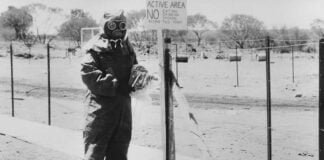Review: What’s Wrong with Anzac? The Militarisation of Australian History
Edited byMarilyn Lake and Henry Reynolds, University of New South Wales Press, $29.95
As our stomachs recover from the gut wrenching hypocrisy of Anzac Day, a new book called What’s Wrong with Anzac? The Militarisation of Australian History comes as a welcome antidote.
Written by leading local historians, this collection of essays expresses serious misgivings about the massive influence of conservative military “historical” analysis on Australian political, social and educational life.
Its editors, Marilyn Lake and Henry Reynolds, argue that it is time to open up a new battlefront in the “history wars”—on the sacred cow of Anzac.
The book takes its starting point from responses to Lake’s recent public lecture, broadcast and newspaper piece on Anzac mythology.
In them, she argued that the story of Anzac has become Australia’s “creation” myth, aggressively promoting the nation’s history as a legacy of imperial, militaristic and masculine values.
The reaction was swift. A blog on the Age newspaper website drew in over 200 contributors, expressing a range of views from support to accusations of treason. “Be quiet and be grateful”, demanded one hostile correspondent.
For supporters of the Anzac story, the invasion of Turkey in 1915 played a vital role in ensuring the democratic “freedoms” that Australians enjoy today.
Moreover, as the mantra goes, Australia became a mature nation in its “baptism of fire” at Gallipoli.
“Our diggers” fought and died selflessly in a spirit of bravery, self-sacrifice and love of nation.
According to the legend, that altruism, loyalty and mateship were quintessentially “Australian” values.
Fighting a fire? Patrolling a beach? Coming from behind to win a footy match? These people have inherited the Anzac spirit too, it’s often claimed.
The book shows how both Labor and Liberal political leaders have worked assiduously to build a sentimental attachment to Anzac mythology, particularly among young children, for nationalistic purposes.
Lake’s work plots the Department of Veterans’ Affairs’ provision of substantial financial support for the development of military “historical” material for school curricula—in fact, what passes for history in this material is naked ideology.
Lest we forget? Not a chance! Indeed, Anzac Day has been celebrated in Australia every year without fail since 1916.
In the hands of its custodian, the RSL, the day eulogises the Anzacs as men of godlike proportions who went to their deaths as heroes – in Turkey, France and the Middle East.
In reality, 60,000 Australians and millions of people from other countries were slaughtered for nothing more than profit—control of colonial booty and trading ascendancy.
The new Returned Sailors and Soldiers Imperial League of Australia (now the RSL) organised what veterans it could into an anti-Labor strike breaking association.
The RSL became a byword for nationalism, militarism, racial exclusion and union busting – Anzac Day is “their” day, where these values get free rein, but not always without opposition.
There have been many attacks on Anzac marches, war memorials and Australian flags.
Alan Seymour’s contentious play, The One Day of the Year, tapped into the late 1950s/early 1960s critique of Anzac Day, portraying war veterans as many people viewed them by then – as beer-swilling martinets and braggarts.
One of the ways in which the popularity of Anzac Day has been rebuilt in recent years is through the renovation of the soldiers’ image.
As the book details, initial reports of the battles in the press unapologetically painted the Anzacs as effective and voracious killers.
“When their blood was up”, wrote the first journalist to report from Gallipoli, Ellis Ashmead-Bartlett, “this race of athletes…rushed northwards and eastwards, searching for fresh enemies to bayonet”.
Now they are commonly portrayed as “tragic heroes” – modest, knockabout blokes who did their duty, even though they were being used by incompetent British military strategists – as if the Australian government did not have its own reasons for sending troops to war.
Problems
While What’s Wrong with Anzac? is a welcome contribution, it also has its problems.
A chapter on anti-war movements, for example, locates the genesis of anti-war sentiment in the 1920s and 1930s and focuses on the contributions by a range of middle-class intellectuals.
There is no mention of the activists who campaigned tirelessly during World War I in the face of harsh government repression.
In particular, the bravery and sacrifice of Industrial Workers of the World members who mounted a trenchant campaign of opposition to conscription and the bloodshed of World War I is not mentioned.
Given many leading members did significant gaol time for their principled stance, this is quite galling.
In addition, it often took a good deal of bravery to attend anti-war rallies organised by the Left, which were repeatedly disrupted by the Empire-loyal thugs of the RSL.
Conservative historian Geoffrey Blainey’s accusation that the book contains unforgiveable gaps and appears rushed is not incorrect. Some sections are repetitive and bland and needed far more editorial attention.
However, his other criticisms are way off the mark—particularly his unfounded assertion that the Howard government spent far more on “Aboriginal history” than military history at the National Museum of Australia.
In reality, historians advising the museum reported significant censorship of exhibitions.
Blainey would like us to think that political narratives like the one surrounding Anzac simply come and go.
“To my mind”, he wrote recently, “Anzac Day, like many symbolic occasions, is partly cyclical. It has risen and waned and risen, and it will wane and rise again.”
In truth, dominant historical interpretations suit the political interests of the ruling class, unless there is active opposition from below.
Anzac mythology serves an often violent Australian capitalist class who seek to justify their actions—from the Boer War to Afghanistan.
Another critic of the book is historian Inga Clendinnen. Although generally suspicious of history in the service of politics, Clendinnen holds a sentimental attachment to the Anzac Days she shared with her veteran father.
She thinks the day should be exempt from critique because it holds an emotional meaning for so many people and upholds important values
However, her stance is reflective of a more general trend where personal attachment to an actual digger is employed to stop criticism of war in its tracks.
Many of Lake’s detractors began by saying something like “my grandfather fought on the Somme” as if that alone proved their arguments.
The power of the personal link has been assiduously cultivated as a way to “remember” even though the last Gallipoli veteran has passed away and fewer people can actually recall relatives who fought there.
Where archives often struggle for project funds, mass digitisation of military personnel files at the National Archives has been supported, enabling many families to find “their” Anzac.
Recently, some historians have defended the importance of this sentiment and ask whether it reflects a search for meaning in a largely secular society.
It is disappointing that Lake and Reynolds’ book is soft on the principal perpetrator of this line, Bruce Scates.
An important and critical historian on other topics, Scates’ book Return to Gallipoli defends the lemming-like backpacker phenomenon at Gallipoli Dawn Services as significant for creating a sense of shared history.
Accentuating individual motivations for travelling to Gallipoli, he fails to acknowledge the powerful ideological forces that encourage backpackers to make “pilgrimages” there.
He cites interviewee after interviewee repeating the same litany—“they sacrificed their lives for us”—claiming a highly questionable connection between the benefits accrued to ordinary Australians and the slaughter of their forebears in battle.
I have my own personal recollection of Anzac Day.
In the early 1960s I was taken to an Anzac Day ceremony with my classmates where the local media went along the lines of school children, asking them about the significance of the day.
At age six, I was only too eager to prattle off that we were there to pay our respects to the soldiers who sacrificed so much for “us”.
This might seem unsurprising, except that I had only been in the country for three years!
The Anzac mythology was simply so rife that even a child could learn it in a short time.
Scates’ sentimentalism has not gone unchallenged.
Historian Mark McKenna has attacked it here and elsewhere. In What’s Wrong with Anzac?, his chapter is worth the price of the book on its own.
In it, he goes a long way towards explaining the upsurge in attendances at dawn services, particularly at Gallipoli.
Australia Day is a failed national day, he argues – despite all the hoopla created for the 1988 Bicentennial by the Hawke government, too many people now associate the First Fleet landing with invasion and genocide.
The ongoing battle by Aboriginal people and their supporters to expose the racist underpinnings of so-called “settlement” in this country has made significant inroads to celebratory versions of Australian history. He writes:
“The history of Aboriginal dispossession, of which Phillip’s landing was the opening act, undercut any attempt to present Australia Day as the rallying point for national pride. Eighteen months later, at Gallipoli, Hawke, like much of the nation’s press, turned to the Anzac story with a sense of relief.”
Unfortunately, the narrative that Lake and Reynolds would prefer to put in its place is just as unconvincing.
They want to celebrate a “slow and patient form of nation-building and are troubled because Australians’ pioneering achievements in building a democratic society and a welfare state, in extending equal rights to women and to Indigenous Australians, in fostering multiculturalism and racial equality have been silenced by the resurgence of the dangerous nineteenth century idea that nations are made in war”.
Clearly, we also need a war on the rosy view that portrays Australia’s history as a steady advance of progressive reforms towards national unity.
By Sarah Gregson





